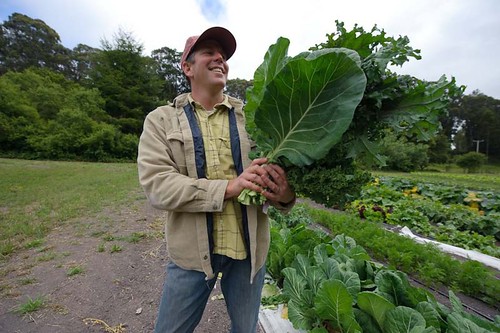
“When we started, there weren’t any other farms locally doing what we were doing,” says Ryan Casey, of Blue House Farms, outside of Pescadero, Calif.
Indeed, Blue House Farms helped spearhead small organic farming in the area, says Jim Howard, District Conservationist for USDA’s Natural Resources Conservation Service (NRCS) in Half Moon Bay—no small feat for a young beginning farmer who started six years ago on only two acres.
Howard and other NRCS specialists have helped farmers like Casey with technical assistance on conservation practices, such as interchangeable drip-to-sprinkler irrigation systems to accommodate complex cropping systems, Integrated Pest Management, hedgerows, cover crops, composting and wildlife habitat enhancement.
Today Casey farms 30 acres with the help of eight employees, and sells his certified organic harvests through a 200-member CSA (community supported agriculture) and at five different farmers markets every week. CSA is a way for consumers to directly invest in local farms and receive a regular delivery of fresh fruits and vegetables.
A tour around San Mateo County now reveals no shortage of small organic farmers, most of them working with NRCS. Many incorporate community education and beginning farmer apprenticeships into their operations, and all of them are energetic and innovative when it comes to new farming practices and conservation.

“We want people to know where their food comes from,” says Jered Lawson, of Pie Ranch.
Each year, the ranch teaches hundreds of high school students about farming by having them harvest crops and make recipes in an outdoor kitchen. And, like many of the other growers, the Pie Ranch often hosts farming workshops, including a recent day-long session on rotating free-range chickens as a way to put nutrients back into the farm’s soil.
NRCS is helping these growers with their innovations through technical and financial assistance. Programs like the Environmental Quality Incentives Program (EQIP) help landowners incorporate such conservation practices as pollinator hedgerows and more efficient irrigation systems.
“Without the NRCS cost-share for our irrigation system, we wouldn’t be able to do what we’re doing,” Casey says. “We wouldn’t be able to be farming at the scale and efficiency.”
Find out more about the EQIP Organic Initiative.
Check out more conservation stories on the USDA blog.
Follow NRCS on Twitter.
